The Effectiveness of Sucrose Solutions in Infant Immunization Research
VerifiedAdded on 2021/06/17
|9
|2194
|47
Report
AI Summary
This report summarizes a randomized control trial investigating the effectiveness of sucrose solutions in reducing pain and distress in infants aged 16-19 months during immunization procedures. The study involved 694 infants, with 537 included after randomization, who were divided into control and experimental groups. The experimental groups received either a 25% or 75% sucrose solution, while the control group received water. Data collection involved maternal questionnaires and videotaping of immunization procedures. The research aimed to determine if sucrose solutions could decrease infant cry time during vaccinations against hepatitis A, pneumococcus, acellular pertussis, tetanus, and diphtheria. Data analysis utilized SPSS, ANOVA, chi-square tests, and binary logistic regressions to compare the groups and identify factors related to pain levels. The findings indicated that oral sucrose administration could reduce cry time, suggesting the potential for sweetening medications to reduce medicine phobia and improve compliance with vaccination schedules. The research design, sampling techniques, and data analysis methods are discussed in detail, along with the study's implications for clinical practice and future research.
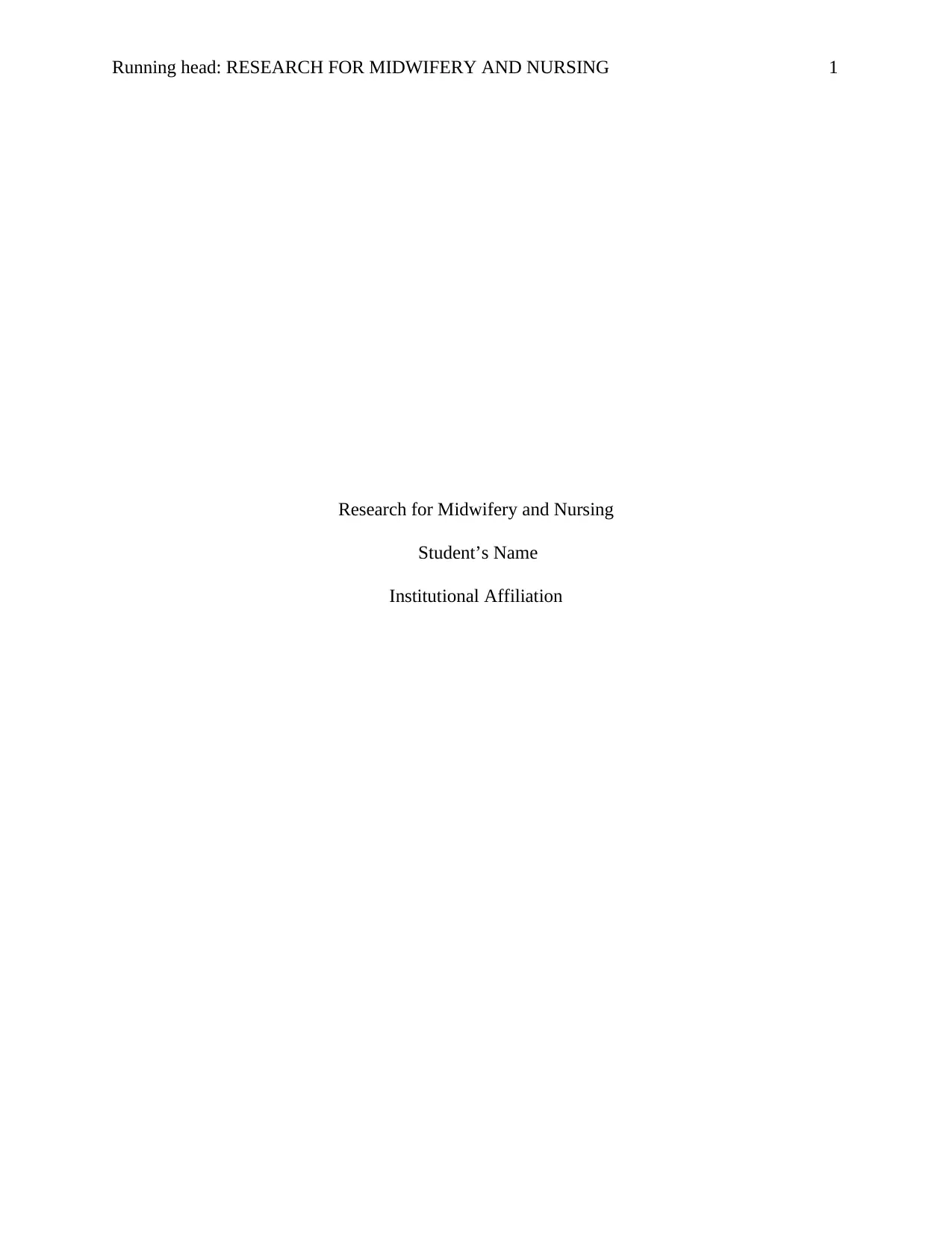
Running head: RESEARCH FOR MIDWIFERY AND NURSING 1
Research for Midwifery and Nursing
Student’s Name
Institutional Affiliation
Research for Midwifery and Nursing
Student’s Name
Institutional Affiliation
Paraphrase This Document
Need a fresh take? Get an instant paraphrase of this document with our AI Paraphraser
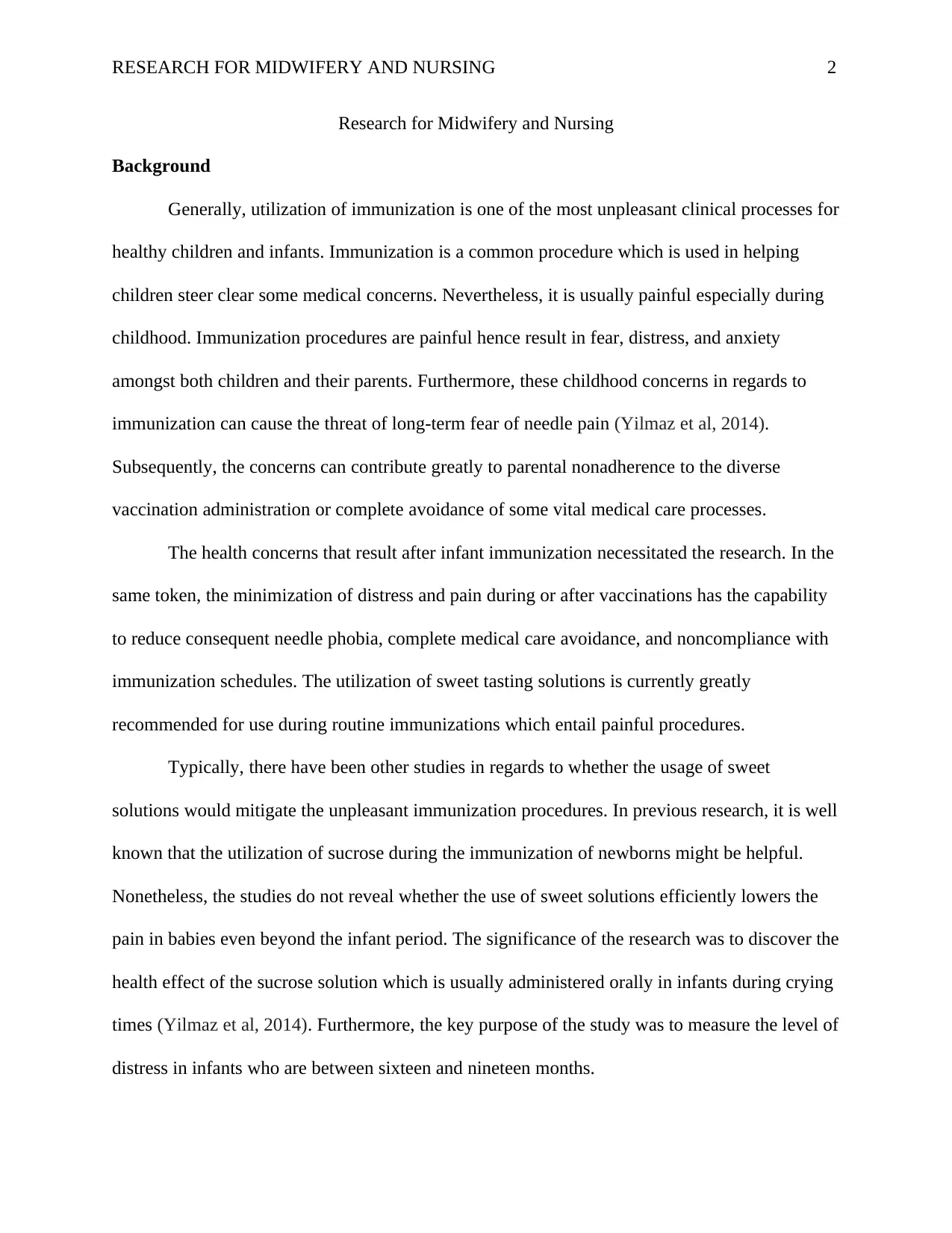
RESEARCH FOR MIDWIFERY AND NURSING 2
Research for Midwifery and Nursing
Background
Generally, utilization of immunization is one of the most unpleasant clinical processes for
healthy children and infants. Immunization is a common procedure which is used in helping
children steer clear some medical concerns. Nevertheless, it is usually painful especially during
childhood. Immunization procedures are painful hence result in fear, distress, and anxiety
amongst both children and their parents. Furthermore, these childhood concerns in regards to
immunization can cause the threat of long-term fear of needle pain (Yilmaz et al, 2014).
Subsequently, the concerns can contribute greatly to parental nonadherence to the diverse
vaccination administration or complete avoidance of some vital medical care processes.
The health concerns that result after infant immunization necessitated the research. In the
same token, the minimization of distress and pain during or after vaccinations has the capability
to reduce consequent needle phobia, complete medical care avoidance, and noncompliance with
immunization schedules. The utilization of sweet tasting solutions is currently greatly
recommended for use during routine immunizations which entail painful procedures.
Typically, there have been other studies in regards to whether the usage of sweet
solutions would mitigate the unpleasant immunization procedures. In previous research, it is well
known that the utilization of sucrose during the immunization of newborns might be helpful.
Nonetheless, the studies do not reveal whether the use of sweet solutions efficiently lowers the
pain in babies even beyond the infant period. The significance of the research was to discover the
health effect of the sucrose solution which is usually administered orally in infants during crying
times (Yilmaz et al, 2014). Furthermore, the key purpose of the study was to measure the level of
distress in infants who are between sixteen and nineteen months.
Research for Midwifery and Nursing
Background
Generally, utilization of immunization is one of the most unpleasant clinical processes for
healthy children and infants. Immunization is a common procedure which is used in helping
children steer clear some medical concerns. Nevertheless, it is usually painful especially during
childhood. Immunization procedures are painful hence result in fear, distress, and anxiety
amongst both children and their parents. Furthermore, these childhood concerns in regards to
immunization can cause the threat of long-term fear of needle pain (Yilmaz et al, 2014).
Subsequently, the concerns can contribute greatly to parental nonadherence to the diverse
vaccination administration or complete avoidance of some vital medical care processes.
The health concerns that result after infant immunization necessitated the research. In the
same token, the minimization of distress and pain during or after vaccinations has the capability
to reduce consequent needle phobia, complete medical care avoidance, and noncompliance with
immunization schedules. The utilization of sweet tasting solutions is currently greatly
recommended for use during routine immunizations which entail painful procedures.
Typically, there have been other studies in regards to whether the usage of sweet
solutions would mitigate the unpleasant immunization procedures. In previous research, it is well
known that the utilization of sucrose during the immunization of newborns might be helpful.
Nonetheless, the studies do not reveal whether the use of sweet solutions efficiently lowers the
pain in babies even beyond the infant period. The significance of the research was to discover the
health effect of the sucrose solution which is usually administered orally in infants during crying
times (Yilmaz et al, 2014). Furthermore, the key purpose of the study was to measure the level of
distress in infants who are between sixteen and nineteen months.
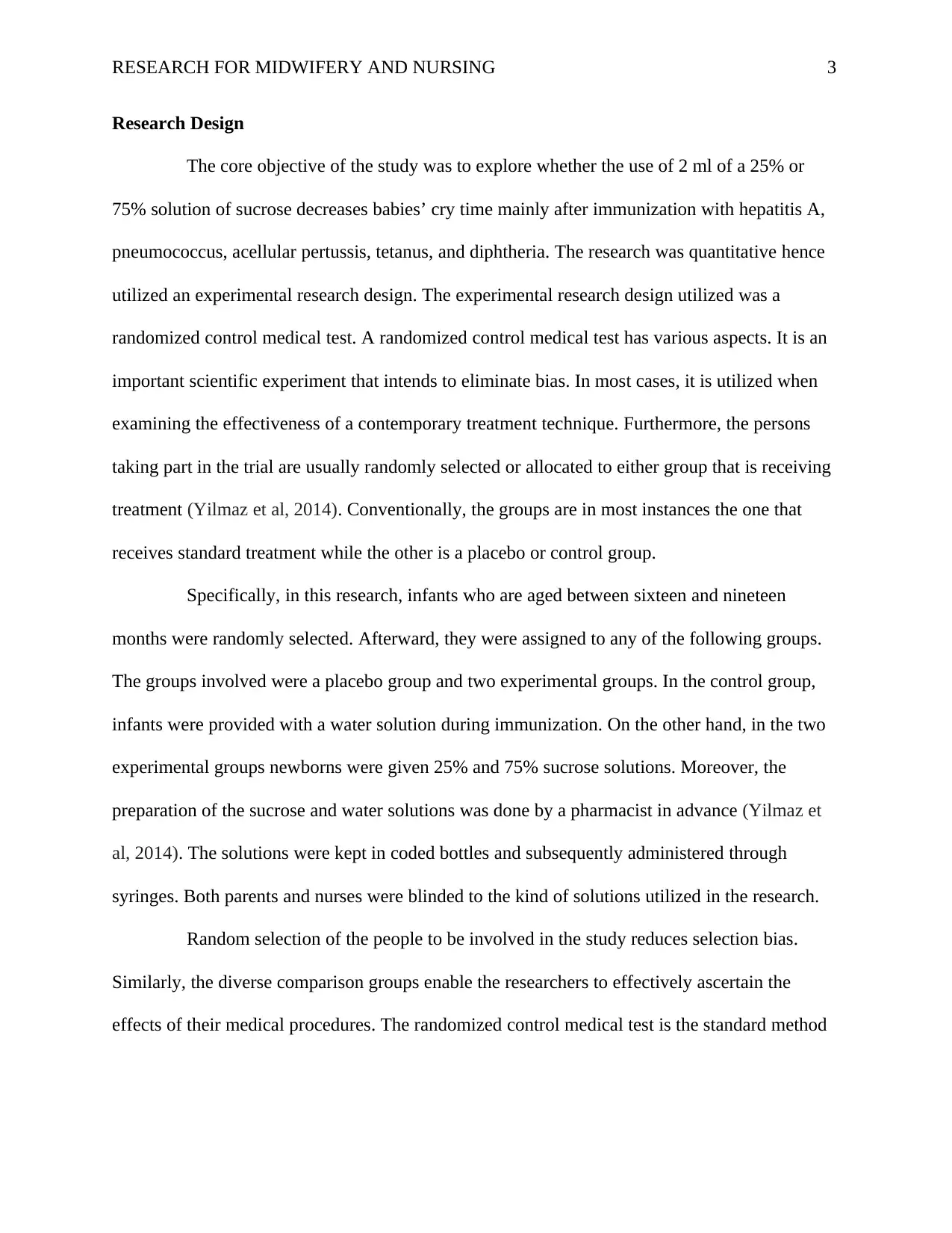
RESEARCH FOR MIDWIFERY AND NURSING 3
Research Design
The core objective of the study was to explore whether the use of 2 ml of a 25% or
75% solution of sucrose decreases babies’ cry time mainly after immunization with hepatitis A,
pneumococcus, acellular pertussis, tetanus, and diphtheria. The research was quantitative hence
utilized an experimental research design. The experimental research design utilized was a
randomized control medical test. A randomized control medical test has various aspects. It is an
important scientific experiment that intends to eliminate bias. In most cases, it is utilized when
examining the effectiveness of a contemporary treatment technique. Furthermore, the persons
taking part in the trial are usually randomly selected or allocated to either group that is receiving
treatment (Yilmaz et al, 2014). Conventionally, the groups are in most instances the one that
receives standard treatment while the other is a placebo or control group.
Specifically, in this research, infants who are aged between sixteen and nineteen
months were randomly selected. Afterward, they were assigned to any of the following groups.
The groups involved were a placebo group and two experimental groups. In the control group,
infants were provided with a water solution during immunization. On the other hand, in the two
experimental groups newborns were given 25% and 75% sucrose solutions. Moreover, the
preparation of the sucrose and water solutions was done by a pharmacist in advance (Yilmaz et
al, 2014). The solutions were kept in coded bottles and subsequently administered through
syringes. Both parents and nurses were blinded to the kind of solutions utilized in the research.
Random selection of the people to be involved in the study reduces selection bias.
Similarly, the diverse comparison groups enable the researchers to effectively ascertain the
effects of their medical procedures. The randomized control medical test is the standard method
Research Design
The core objective of the study was to explore whether the use of 2 ml of a 25% or
75% solution of sucrose decreases babies’ cry time mainly after immunization with hepatitis A,
pneumococcus, acellular pertussis, tetanus, and diphtheria. The research was quantitative hence
utilized an experimental research design. The experimental research design utilized was a
randomized control medical test. A randomized control medical test has various aspects. It is an
important scientific experiment that intends to eliminate bias. In most cases, it is utilized when
examining the effectiveness of a contemporary treatment technique. Furthermore, the persons
taking part in the trial are usually randomly selected or allocated to either group that is receiving
treatment (Yilmaz et al, 2014). Conventionally, the groups are in most instances the one that
receives standard treatment while the other is a placebo or control group.
Specifically, in this research, infants who are aged between sixteen and nineteen
months were randomly selected. Afterward, they were assigned to any of the following groups.
The groups involved were a placebo group and two experimental groups. In the control group,
infants were provided with a water solution during immunization. On the other hand, in the two
experimental groups newborns were given 25% and 75% sucrose solutions. Moreover, the
preparation of the sucrose and water solutions was done by a pharmacist in advance (Yilmaz et
al, 2014). The solutions were kept in coded bottles and subsequently administered through
syringes. Both parents and nurses were blinded to the kind of solutions utilized in the research.
Random selection of the people to be involved in the study reduces selection bias.
Similarly, the diverse comparison groups enable the researchers to effectively ascertain the
effects of their medical procedures. The randomized control medical test is the standard method
⊘ This is a preview!⊘
Do you want full access?
Subscribe today to unlock all pages.

Trusted by 1+ million students worldwide
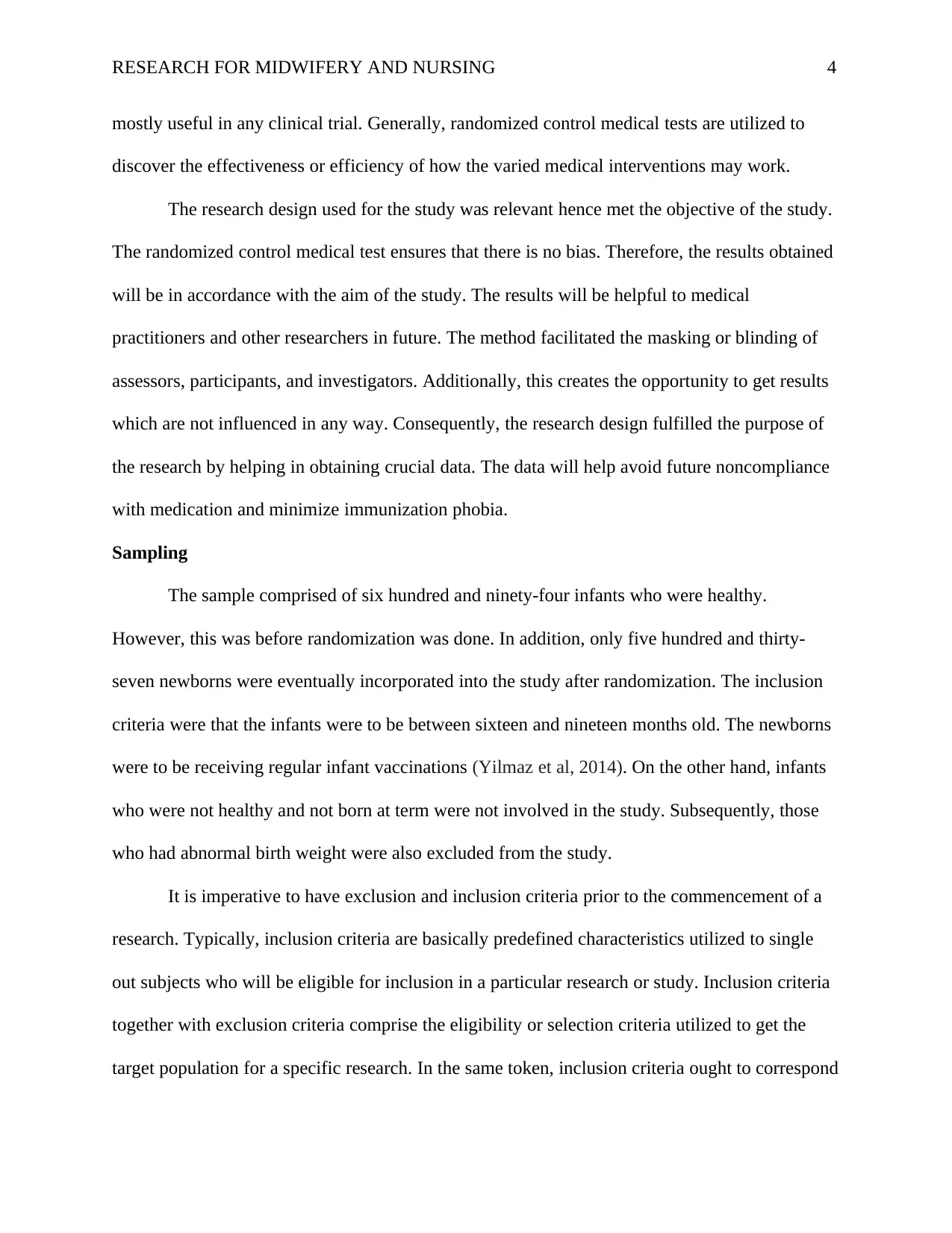
RESEARCH FOR MIDWIFERY AND NURSING 4
mostly useful in any clinical trial. Generally, randomized control medical tests are utilized to
discover the effectiveness or efficiency of how the varied medical interventions may work.
The research design used for the study was relevant hence met the objective of the study.
The randomized control medical test ensures that there is no bias. Therefore, the results obtained
will be in accordance with the aim of the study. The results will be helpful to medical
practitioners and other researchers in future. The method facilitated the masking or blinding of
assessors, participants, and investigators. Additionally, this creates the opportunity to get results
which are not influenced in any way. Consequently, the research design fulfilled the purpose of
the research by helping in obtaining crucial data. The data will help avoid future noncompliance
with medication and minimize immunization phobia.
Sampling
The sample comprised of six hundred and ninety-four infants who were healthy.
However, this was before randomization was done. In addition, only five hundred and thirty-
seven newborns were eventually incorporated into the study after randomization. The inclusion
criteria were that the infants were to be between sixteen and nineteen months old. The newborns
were to be receiving regular infant vaccinations (Yilmaz et al, 2014). On the other hand, infants
who were not healthy and not born at term were not involved in the study. Subsequently, those
who had abnormal birth weight were also excluded from the study.
It is imperative to have exclusion and inclusion criteria prior to the commencement of a
research. Typically, inclusion criteria are basically predefined characteristics utilized to single
out subjects who will be eligible for inclusion in a particular research or study. Inclusion criteria
together with exclusion criteria comprise the eligibility or selection criteria utilized to get the
target population for a specific research. In the same token, inclusion criteria ought to correspond
mostly useful in any clinical trial. Generally, randomized control medical tests are utilized to
discover the effectiveness or efficiency of how the varied medical interventions may work.
The research design used for the study was relevant hence met the objective of the study.
The randomized control medical test ensures that there is no bias. Therefore, the results obtained
will be in accordance with the aim of the study. The results will be helpful to medical
practitioners and other researchers in future. The method facilitated the masking or blinding of
assessors, participants, and investigators. Additionally, this creates the opportunity to get results
which are not influenced in any way. Consequently, the research design fulfilled the purpose of
the research by helping in obtaining crucial data. The data will help avoid future noncompliance
with medication and minimize immunization phobia.
Sampling
The sample comprised of six hundred and ninety-four infants who were healthy.
However, this was before randomization was done. In addition, only five hundred and thirty-
seven newborns were eventually incorporated into the study after randomization. The inclusion
criteria were that the infants were to be between sixteen and nineteen months old. The newborns
were to be receiving regular infant vaccinations (Yilmaz et al, 2014). On the other hand, infants
who were not healthy and not born at term were not involved in the study. Subsequently, those
who had abnormal birth weight were also excluded from the study.
It is imperative to have exclusion and inclusion criteria prior to the commencement of a
research. Typically, inclusion criteria are basically predefined characteristics utilized to single
out subjects who will be eligible for inclusion in a particular research or study. Inclusion criteria
together with exclusion criteria comprise the eligibility or selection criteria utilized to get the
target population for a specific research. In the same token, inclusion criteria ought to correspond
Paraphrase This Document
Need a fresh take? Get an instant paraphrase of this document with our AI Paraphraser
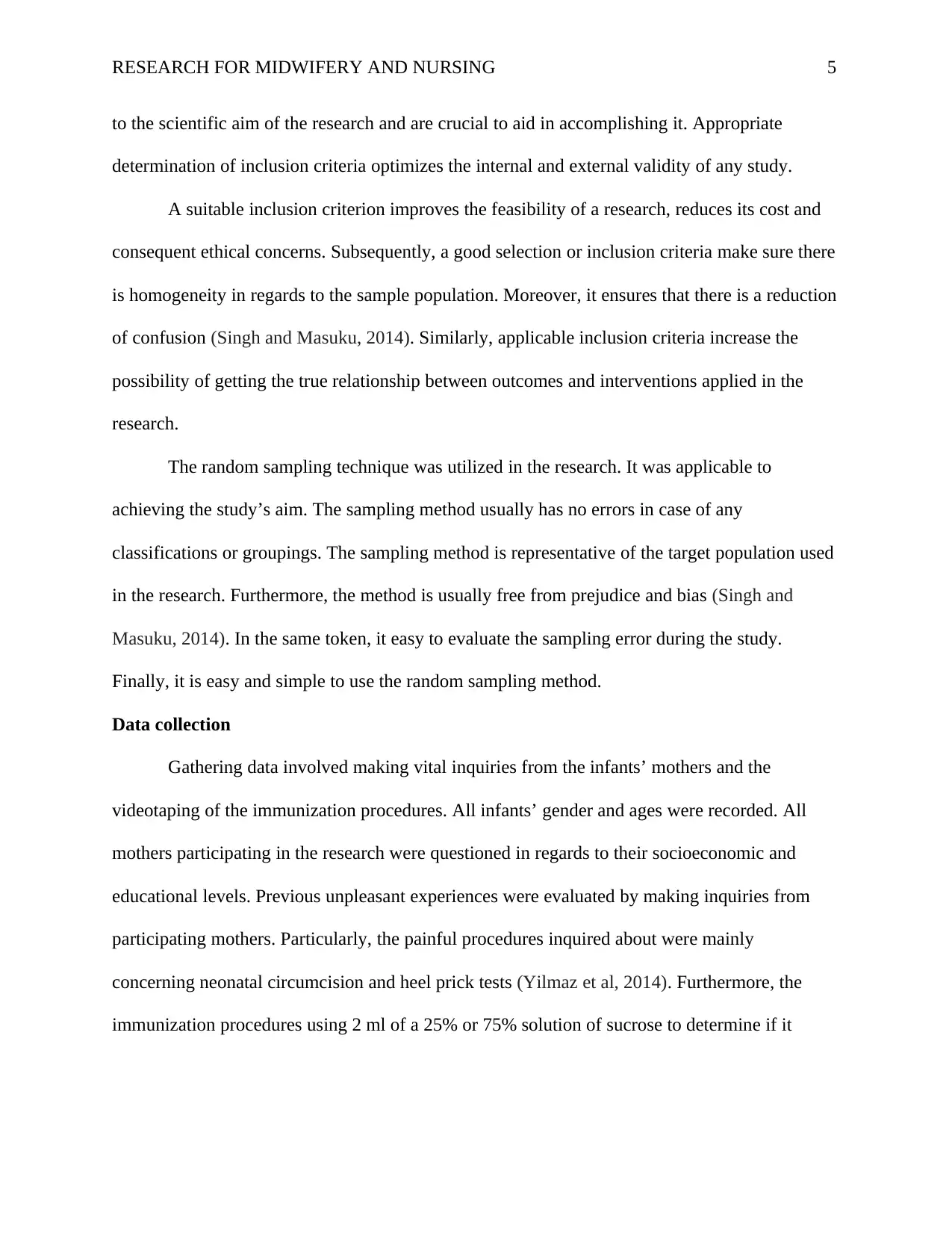
RESEARCH FOR MIDWIFERY AND NURSING 5
to the scientific aim of the research and are crucial to aid in accomplishing it. Appropriate
determination of inclusion criteria optimizes the internal and external validity of any study.
A suitable inclusion criterion improves the feasibility of a research, reduces its cost and
consequent ethical concerns. Subsequently, a good selection or inclusion criteria make sure there
is homogeneity in regards to the sample population. Moreover, it ensures that there is a reduction
of confusion (Singh and Masuku, 2014). Similarly, applicable inclusion criteria increase the
possibility of getting the true relationship between outcomes and interventions applied in the
research.
The random sampling technique was utilized in the research. It was applicable to
achieving the study’s aim. The sampling method usually has no errors in case of any
classifications or groupings. The sampling method is representative of the target population used
in the research. Furthermore, the method is usually free from prejudice and bias (Singh and
Masuku, 2014). In the same token, it easy to evaluate the sampling error during the study.
Finally, it is easy and simple to use the random sampling method.
Data collection
Gathering data involved making vital inquiries from the infants’ mothers and the
videotaping of the immunization procedures. All infants’ gender and ages were recorded. All
mothers participating in the research were questioned in regards to their socioeconomic and
educational levels. Previous unpleasant experiences were evaluated by making inquiries from
participating mothers. Particularly, the painful procedures inquired about were mainly
concerning neonatal circumcision and heel prick tests (Yilmaz et al, 2014). Furthermore, the
immunization procedures using 2 ml of a 25% or 75% solution of sucrose to determine if it
to the scientific aim of the research and are crucial to aid in accomplishing it. Appropriate
determination of inclusion criteria optimizes the internal and external validity of any study.
A suitable inclusion criterion improves the feasibility of a research, reduces its cost and
consequent ethical concerns. Subsequently, a good selection or inclusion criteria make sure there
is homogeneity in regards to the sample population. Moreover, it ensures that there is a reduction
of confusion (Singh and Masuku, 2014). Similarly, applicable inclusion criteria increase the
possibility of getting the true relationship between outcomes and interventions applied in the
research.
The random sampling technique was utilized in the research. It was applicable to
achieving the study’s aim. The sampling method usually has no errors in case of any
classifications or groupings. The sampling method is representative of the target population used
in the research. Furthermore, the method is usually free from prejudice and bias (Singh and
Masuku, 2014). In the same token, it easy to evaluate the sampling error during the study.
Finally, it is easy and simple to use the random sampling method.
Data collection
Gathering data involved making vital inquiries from the infants’ mothers and the
videotaping of the immunization procedures. All infants’ gender and ages were recorded. All
mothers participating in the research were questioned in regards to their socioeconomic and
educational levels. Previous unpleasant experiences were evaluated by making inquiries from
participating mothers. Particularly, the painful procedures inquired about were mainly
concerning neonatal circumcision and heel prick tests (Yilmaz et al, 2014). Furthermore, the
immunization procedures using 2 ml of a 25% or 75% solution of sucrose to determine if it
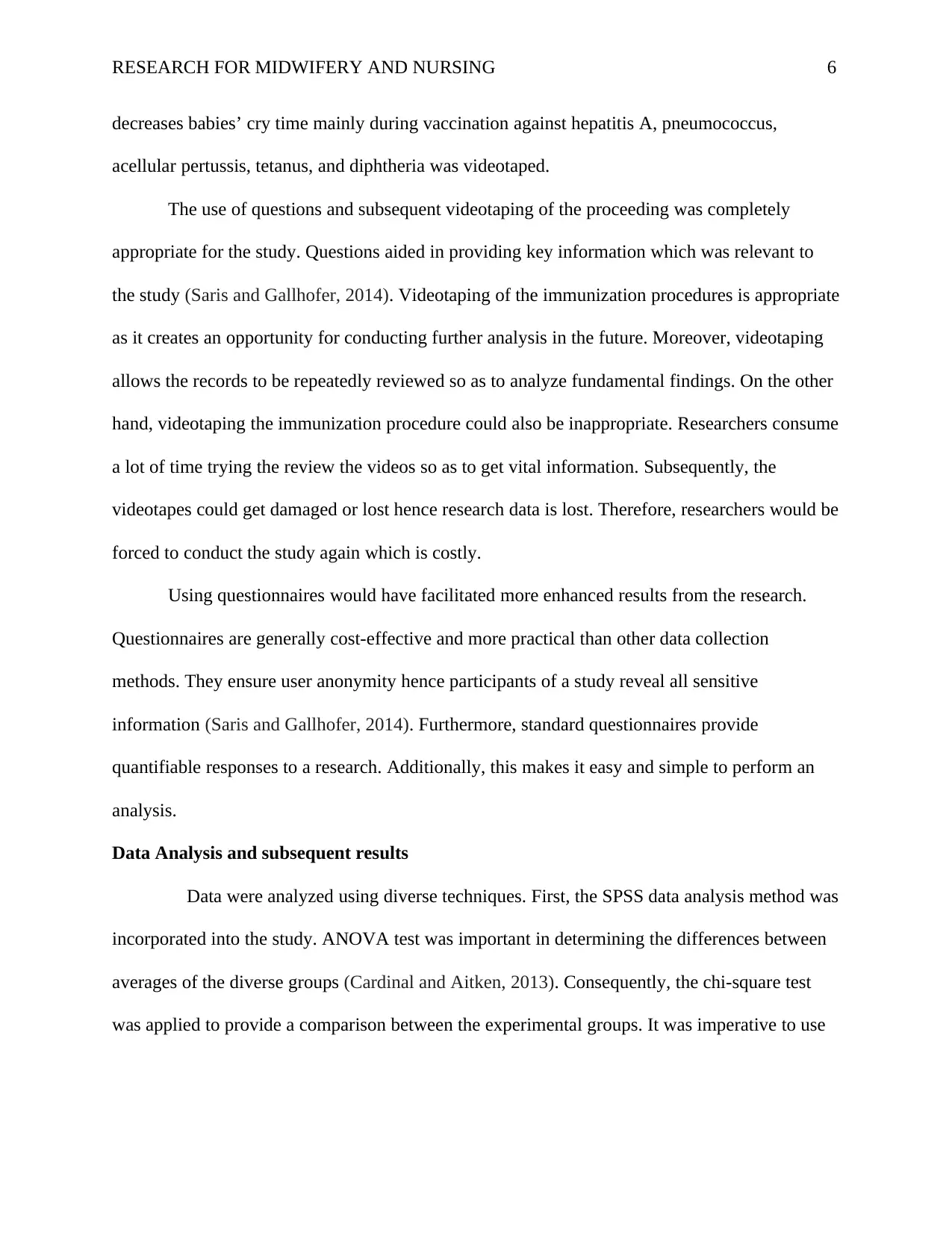
RESEARCH FOR MIDWIFERY AND NURSING 6
decreases babies’ cry time mainly during vaccination against hepatitis A, pneumococcus,
acellular pertussis, tetanus, and diphtheria was videotaped.
The use of questions and subsequent videotaping of the proceeding was completely
appropriate for the study. Questions aided in providing key information which was relevant to
the study (Saris and Gallhofer, 2014). Videotaping of the immunization procedures is appropriate
as it creates an opportunity for conducting further analysis in the future. Moreover, videotaping
allows the records to be repeatedly reviewed so as to analyze fundamental findings. On the other
hand, videotaping the immunization procedure could also be inappropriate. Researchers consume
a lot of time trying the review the videos so as to get vital information. Subsequently, the
videotapes could get damaged or lost hence research data is lost. Therefore, researchers would be
forced to conduct the study again which is costly.
Using questionnaires would have facilitated more enhanced results from the research.
Questionnaires are generally cost-effective and more practical than other data collection
methods. They ensure user anonymity hence participants of a study reveal all sensitive
information (Saris and Gallhofer, 2014). Furthermore, standard questionnaires provide
quantifiable responses to a research. Additionally, this makes it easy and simple to perform an
analysis.
Data Analysis and subsequent results
Data were analyzed using diverse techniques. First, the SPSS data analysis method was
incorporated into the study. ANOVA test was important in determining the differences between
averages of the diverse groups (Cardinal and Aitken, 2013). Consequently, the chi-square test
was applied to provide a comparison between the experimental groups. It was imperative to use
decreases babies’ cry time mainly during vaccination against hepatitis A, pneumococcus,
acellular pertussis, tetanus, and diphtheria was videotaped.
The use of questions and subsequent videotaping of the proceeding was completely
appropriate for the study. Questions aided in providing key information which was relevant to
the study (Saris and Gallhofer, 2014). Videotaping of the immunization procedures is appropriate
as it creates an opportunity for conducting further analysis in the future. Moreover, videotaping
allows the records to be repeatedly reviewed so as to analyze fundamental findings. On the other
hand, videotaping the immunization procedure could also be inappropriate. Researchers consume
a lot of time trying the review the videos so as to get vital information. Subsequently, the
videotapes could get damaged or lost hence research data is lost. Therefore, researchers would be
forced to conduct the study again which is costly.
Using questionnaires would have facilitated more enhanced results from the research.
Questionnaires are generally cost-effective and more practical than other data collection
methods. They ensure user anonymity hence participants of a study reveal all sensitive
information (Saris and Gallhofer, 2014). Furthermore, standard questionnaires provide
quantifiable responses to a research. Additionally, this makes it easy and simple to perform an
analysis.
Data Analysis and subsequent results
Data were analyzed using diverse techniques. First, the SPSS data analysis method was
incorporated into the study. ANOVA test was important in determining the differences between
averages of the diverse groups (Cardinal and Aitken, 2013). Consequently, the chi-square test
was applied to provide a comparison between the experimental groups. It was imperative to use
⊘ This is a preview!⊘
Do you want full access?
Subscribe today to unlock all pages.

Trusted by 1+ million students worldwide
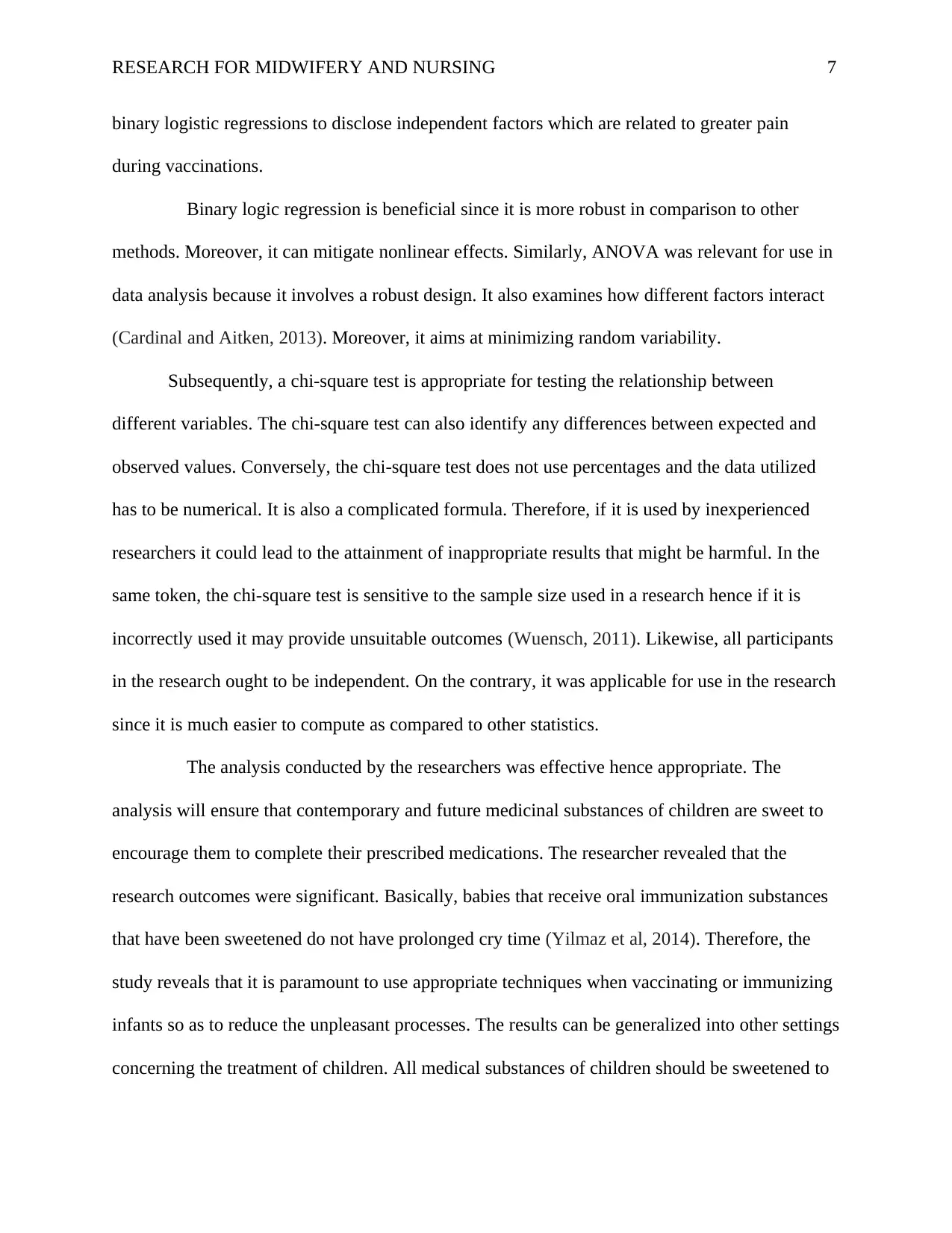
RESEARCH FOR MIDWIFERY AND NURSING 7
binary logistic regressions to disclose independent factors which are related to greater pain
during vaccinations.
Binary logic regression is beneficial since it is more robust in comparison to other
methods. Moreover, it can mitigate nonlinear effects. Similarly, ANOVA was relevant for use in
data analysis because it involves a robust design. It also examines how different factors interact
(Cardinal and Aitken, 2013). Moreover, it aims at minimizing random variability.
Subsequently, a chi-square test is appropriate for testing the relationship between
different variables. The chi-square test can also identify any differences between expected and
observed values. Conversely, the chi-square test does not use percentages and the data utilized
has to be numerical. It is also a complicated formula. Therefore, if it is used by inexperienced
researchers it could lead to the attainment of inappropriate results that might be harmful. In the
same token, the chi-square test is sensitive to the sample size used in a research hence if it is
incorrectly used it may provide unsuitable outcomes (Wuensch, 2011). Likewise, all participants
in the research ought to be independent. On the contrary, it was applicable for use in the research
since it is much easier to compute as compared to other statistics.
The analysis conducted by the researchers was effective hence appropriate. The
analysis will ensure that contemporary and future medicinal substances of children are sweet to
encourage them to complete their prescribed medications. The researcher revealed that the
research outcomes were significant. Basically, babies that receive oral immunization substances
that have been sweetened do not have prolonged cry time (Yilmaz et al, 2014). Therefore, the
study reveals that it is paramount to use appropriate techniques when vaccinating or immunizing
infants so as to reduce the unpleasant processes. The results can be generalized into other settings
concerning the treatment of children. All medical substances of children should be sweetened to
binary logistic regressions to disclose independent factors which are related to greater pain
during vaccinations.
Binary logic regression is beneficial since it is more robust in comparison to other
methods. Moreover, it can mitigate nonlinear effects. Similarly, ANOVA was relevant for use in
data analysis because it involves a robust design. It also examines how different factors interact
(Cardinal and Aitken, 2013). Moreover, it aims at minimizing random variability.
Subsequently, a chi-square test is appropriate for testing the relationship between
different variables. The chi-square test can also identify any differences between expected and
observed values. Conversely, the chi-square test does not use percentages and the data utilized
has to be numerical. It is also a complicated formula. Therefore, if it is used by inexperienced
researchers it could lead to the attainment of inappropriate results that might be harmful. In the
same token, the chi-square test is sensitive to the sample size used in a research hence if it is
incorrectly used it may provide unsuitable outcomes (Wuensch, 2011). Likewise, all participants
in the research ought to be independent. On the contrary, it was applicable for use in the research
since it is much easier to compute as compared to other statistics.
The analysis conducted by the researchers was effective hence appropriate. The
analysis will ensure that contemporary and future medicinal substances of children are sweet to
encourage them to complete their prescribed medications. The researcher revealed that the
research outcomes were significant. Basically, babies that receive oral immunization substances
that have been sweetened do not have prolonged cry time (Yilmaz et al, 2014). Therefore, the
study reveals that it is paramount to use appropriate techniques when vaccinating or immunizing
infants so as to reduce the unpleasant processes. The results can be generalized into other settings
concerning the treatment of children. All medical substances of children should be sweetened to
Paraphrase This Document
Need a fresh take? Get an instant paraphrase of this document with our AI Paraphraser

RESEARCH FOR MIDWIFERY AND NURSING 8
avoid development of medicine phobia. Therefore, children will not steer clear any medicines
since they will be appropriate for use to them.
avoid development of medicine phobia. Therefore, children will not steer clear any medicines
since they will be appropriate for use to them.
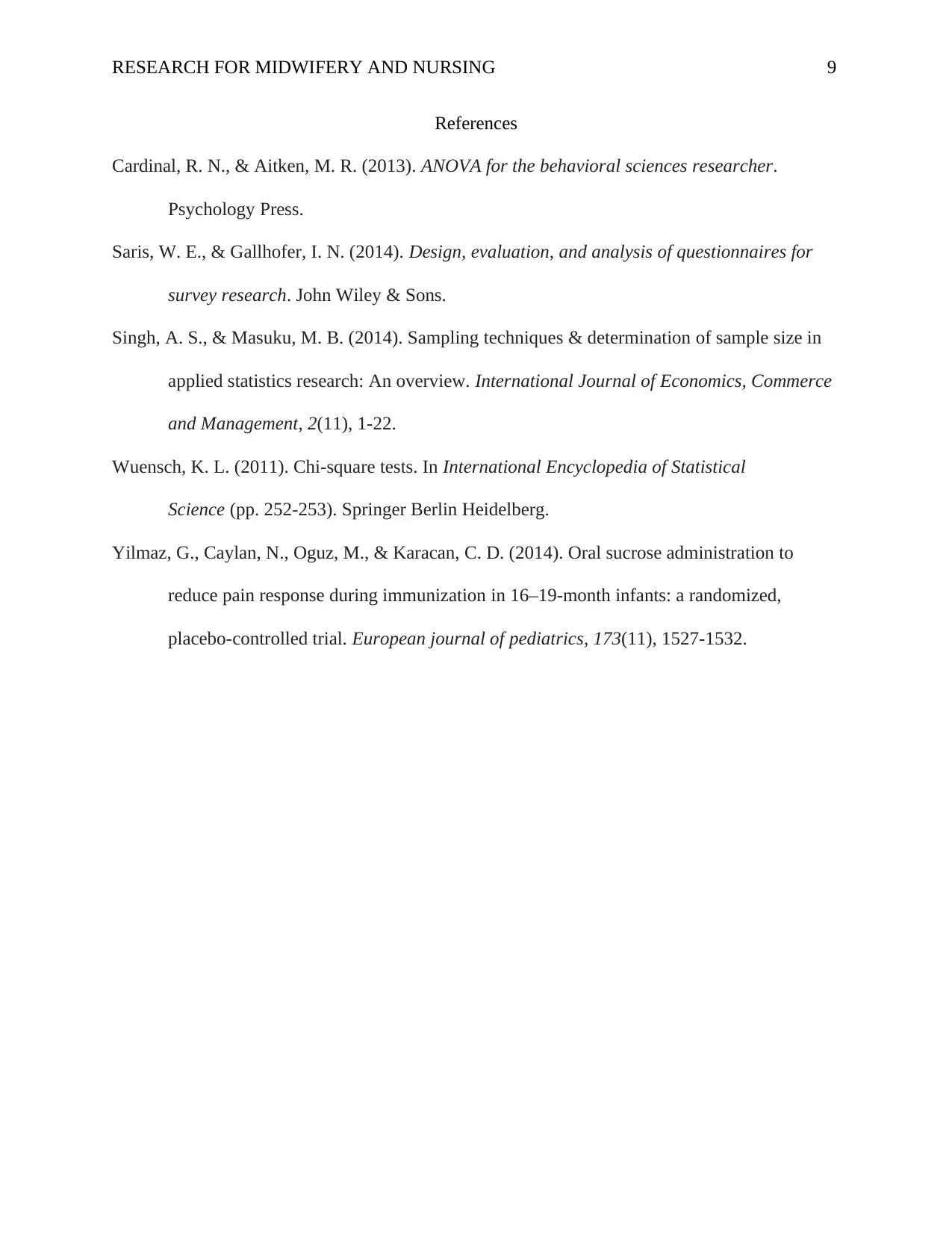
RESEARCH FOR MIDWIFERY AND NURSING 9
References
Cardinal, R. N., & Aitken, M. R. (2013). ANOVA for the behavioral sciences researcher.
Psychology Press.
Saris, W. E., & Gallhofer, I. N. (2014). Design, evaluation, and analysis of questionnaires for
survey research. John Wiley & Sons.
Singh, A. S., & Masuku, M. B. (2014). Sampling techniques & determination of sample size in
applied statistics research: An overview. International Journal of Economics, Commerce
and Management, 2(11), 1-22.
Wuensch, K. L. (2011). Chi-square tests. In International Encyclopedia of Statistical
Science (pp. 252-253). Springer Berlin Heidelberg.
Yilmaz, G., Caylan, N., Oguz, M., & Karacan, C. D. (2014). Oral sucrose administration to
reduce pain response during immunization in 16–19-month infants: a randomized,
placebo-controlled trial. European journal of pediatrics, 173(11), 1527-1532.
References
Cardinal, R. N., & Aitken, M. R. (2013). ANOVA for the behavioral sciences researcher.
Psychology Press.
Saris, W. E., & Gallhofer, I. N. (2014). Design, evaluation, and analysis of questionnaires for
survey research. John Wiley & Sons.
Singh, A. S., & Masuku, M. B. (2014). Sampling techniques & determination of sample size in
applied statistics research: An overview. International Journal of Economics, Commerce
and Management, 2(11), 1-22.
Wuensch, K. L. (2011). Chi-square tests. In International Encyclopedia of Statistical
Science (pp. 252-253). Springer Berlin Heidelberg.
Yilmaz, G., Caylan, N., Oguz, M., & Karacan, C. D. (2014). Oral sucrose administration to
reduce pain response during immunization in 16–19-month infants: a randomized,
placebo-controlled trial. European journal of pediatrics, 173(11), 1527-1532.
⊘ This is a preview!⊘
Do you want full access?
Subscribe today to unlock all pages.

Trusted by 1+ million students worldwide
1 out of 9
Related Documents
Your All-in-One AI-Powered Toolkit for Academic Success.
+13062052269
info@desklib.com
Available 24*7 on WhatsApp / Email
![[object Object]](/_next/static/media/star-bottom.7253800d.svg)
Unlock your academic potential
Copyright © 2020–2025 A2Z Services. All Rights Reserved. Developed and managed by ZUCOL.




